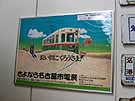
A farewell poster telling closure of tram srvice of Nagoya city in March 1973.

A farewell poster telling closure of tram srvice of Nagoya city in March 1973.
|
Although it is moderate in size, the Nagoya City Tram and Subway
Museum,
located next to Nisshin Workshops, is well worth a visit if you are in
the area. As its name suggests, its exhibits are of two types. One
group are trams from the Nagoya City system. The first line opened in
May 1898 and lines covered 42.5 kms by the time they became publicly
operated in 1922. By 1959 system length reached 108 kms, with 415 cars
operating 26 routes. The first one-man tram operation had begun in
1954. However, the system declined with increasing car ownership and
the development of the subway system and the last line closed at the
end of March 1974.
The busiest section was always between Mei Eki (Nagoya Station) and
Sakae, the main shopping and entertainment area. This led to the use of
36 eighteen metre six-axle articulated sets (types 2600, 2700 and
3000).
Preserved in the museum is set 3003, in use from 1944 until 1970. Also
preserved are cars 1421 (type 1400) and 2017 (type 2000). They were
both built by local manufacturer, Nippon Sharyo, with the former
operating from 1938 until the end of the system, and the latter
operating between 1956 and 1972.
With high car use in the Nagoya area, a major car producing centre,
Nagoya's subway system has not been able to match levels of ridership
in Tokyo or Osaka. Now with two standard gauge 600 volts 3rd-rail
lines, the
Higashiyama and Meijo, and two 1067 mm lines with 1500 volts overhead
electrification, the system features through running with Meitetsu
(Nagoya Railroad) on the Tsurumai Line and operation over the new
3rd-sector Kamiida Line. The next part of the Meijo Line (line 4) opens
in December 2003 and an extension is planned to the Sakuradori Line.
The system covers over 80 kilometres and carries 1.1 million passengers
a day.
Although subway stock is now all of modern unpainted design, the
museum
celebrates the yellow painted trains which were originally used on the
Higashiyama Line (opened from November 1957) and the Meijo Line (opened
from October 1965). Cars 107 and 108 (type 100) were the original type
on the Higashiyama Line. Other yellow cars have been rebuilt for use on
local private lines in Japan or, like Tokyo Marunouchi Line cars,
exported to Argentina for the Buenos Aires subway.
Other exhibits include photos and maps. They are particularly
interesting
in showing how much Nagoya's outer suburbs have developed with the
growth of the subway. Nearest station to the museum is Akaike (Tsurumai
Line). It is then a few minutes walk, including crossing Route 153. The
entrance is marked by tunnel shield boring equipment used on recent
extension work.